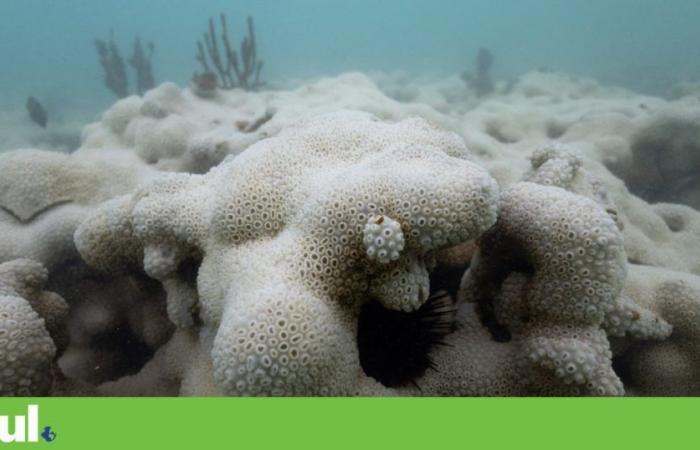Brazil is preparing for what could be the worst money laundering event corals as usual: extremely hot waters are damaging the reefs of the country’s largest marine reserve — also threatening tourism and fishing revenues in the region.
As the world’s corals are experiencing their fourth mass bleaching event in three decades, some had hoped that Brazil’s reefs would be spared, as happened during previous episodes of global coral bleaching. But not.
Bleaching is triggered by high water temperatures, which cause corals to expel the colored algae that live in their tissues. Without the algae that provide nutrients, corals begin to starve.
“No one has ever called me about bleaching in Brazil,” said Greg Asner, director of the Allen Coral Atlas program, which monitors reefs worldwide via satellite.
JORGE SILVA/REUTERS
But in Brazil, huge swaths of coral have turned bone white along Brazil’s vast Atlantic coast, from the northeastern states of Alagoas to Rio Grande do Norte, including the 75-mile-long marine park called Costa dos Corais.
Four scientists who monitor these corals told Reuters that this year is on track to have the worst bleaching on record in the Coral Coast and possibly in the entire country.
Sea temperatures broke records last year as sea temperatures climate change exacerbated the effects of the cyclical phenomenon El Niño, which typically warms the globe every six to seven years. O El Niño is a natural climate phenomenon in which the surface waters of the equatorial Pacific become warmer than normal, which causes changes in weather patterns, which can affect the climate at a global level.
Brazilian reefs are somewhat isolated from the better-known reefs in the Caribbean and have the highest percentage of corals found nowhere else on the planet, including at least seven species threatened with extinction, according to the International Union for Conservation of Nature. Nature (IUCN).
JORGE SILVA/REUTERS
Almost 100% of the corals in some parts of the marine park were affected, and some began to die, said Miguel Mies, director of research at the Instituto Coral Vivo. A less famous reef at the tip of Brazil, near the city of Natal, is being even more affected, he said.
Some divers on the Coral Coast measured water temperatures of around 33 degrees Celsius, above the temperature at which corals feel most comfortable, which is around 27 degrees Celsius.
“The bleaching is intense,” Pedro Pereira, coordinator of the Reef Conservation Project, a non-profit organization, told Reuters between dives to inspect the reef. “We are seeing the extinction, before our eyes, of a ecosystem so beautiful and wonderful”, he said.
The damage
To the coastal city of Maragogi, the brightly colored reefs and blue waters The Coral Coast’s crystal clear views have helped build a thriving tourism industry. Reef tourism generates around 908 million reais per year (around 164 million euros) for Maragogi and the neighboring municipalities of Ipojuca and São Miguel dos Milagres, according to the Fundação Grupo Boticário.
JORGE SILVA/REUTERS
Thousands of people in the region also work in artisanal fishing, practically the only economic alternative to tourism, said Cláudio Sampaio, professor of fisheries engineering at the Federal University of Alagoas.
This year, catches of octopus, fish and shrimp have declined with bleaching and high temperatures, adding to existing problems of pollution and overfishing, said Johnny Antonio da Silva Lima, a 40-year-old fisherman who lives on the Coral Coast. . “Sometimes it’s unbearable heat,” said Silva Lima.
“We feel this because we are always walking on the rocks, looking for octopuses, mainly, and also fishing with pole lines on the edge of the corals. We feel it firsthand.”
Most of Brazil’s corals live in murkier waters, which helps protect them from the sun, and grow in massive formations, which also make them more resilient, according to a 2020 study.
Previously, these reefs had only been hit by a deadly bleaching event in 2019-2020, which killed up to 50% of the region’s distinct brain coral species and 90% of the coral Millepora alcicornis. The current bleaching is affecting these same species again in the Costa dos Corais park, said Miguel Mies.
Corals are animals that have a symbiotic relationship with microalgae that live in their tissues, giving them their bright colors, which are lost in a bleaching event.
“A bleached coral would be something like if we humans suddenly had transparent skin and organs. So we could see our bones beneath our skin,” Mies said. Corals could recover if the waters cooled in time to be repopulated by microalgae.
Whether the current bleaching event becomes the most severe on record nationally will depend on whether the Abrolhos Reef, further south, is also as damaged as it was in 2020, Mies said.
So far, the Abrolhos Reef has suffered limited impact. But, with the waters expected to remain warm throughout April, Mies says that could change.
Whatever survives must be studied to determine what characteristics helped make it more resilient, as scientists are trying to learn which species can withstand climate change, said Asner of the Allen Coral Atlas program. “These will be the genetic individuals that propagate and flourish in a future world,” she said.






